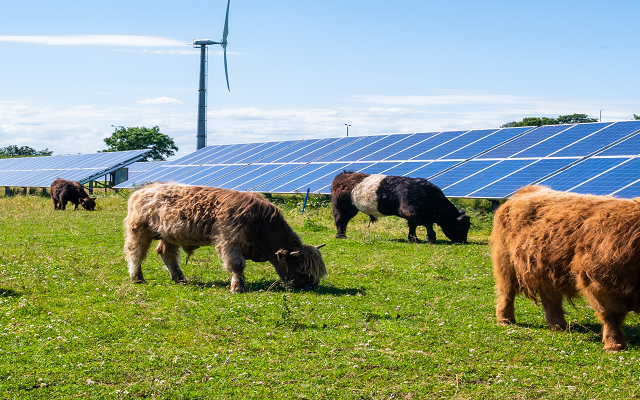Land Business Update | Week Commencing 5th February 2024
Welcome to our fortnightly update on key land management, farming, planning, forestry, environmental and energy issues.
Farmland market in England
English farmland market – non-farmers bought more than half of farms and estates in 2023
Farmer buyers accounted for the lowest level of transactions on record – 44% of open market transactions in 2023 when historically they have tended to be involved in 50-60% of purchases. The non-farmer buyers – who are a mix of private and institutional investors and lifestyle buyers – bought almost double the area of land than farmers as they tend to buy larger farms. Demand was slightly weaker in 2023 than in 2022, with interest becoming more variable in some regions, leading to a slightly lower percentage of farms and estates selling at or above the guide price. However, high prices have continued to be paid for best-in-class properties, pushing up average values. The average price of arable land in England rose by 4% between 2022 and 2023, with an average price paid of £11,300/acre. As is usual, there was a much greater variability in pasture prices, because grassland can differ so much in terms of quality, with prices ranging from a low of £4,000/acre to a high of £16,100/acre, with an average of £8,700/acre. Please read our English Estates and Farmland Market Review and contact Matthew Sudlow, head of Estates and Farms Agency, if you would like to discuss a sale or purchase. You can also listen to Matthew on Farming Today on 29th January (first subject discussed).
Energy
BECCS project approved but NAO warns about biomass sustainability claims
The government has approved Drax’s application to build a bioenergy with carbon capture and storage (BECCS) plant in Yorkshire. Critics claim that burning wood for power is often not carbon neutral given the time it takes for ‘replacement’ trees to grow to recapture the carbon released. A new National Audit Office report also says that there is a lack of robust evaluation that biomass energy can meet its sustainability claims.
Farming
Horticulture sector warns of existential threat from full border controls starting in May
The government intends to physically check 100% of plant consignments that are imported into the UK under the full Border Target Operating Model. It is part of the nation’s biosecurity system. The horticulture sector, on both sides of the Channel, is concerned that UK border posts have the capacity to do this without delays that could damage the plants. The Model, which has already been delayed five times, requires that medium- and high-risk animal and plant products, which covers almost all young plants, have a health certificate from 31st January 2024. They will also have a physical check after 30th April.
Carbon pricing in agriculture needed to reach net zero
A form of emissions pricing and a shift away from agricultural activities that are higher emissions are both needed, according to a new study by the EU’s European Scientific Advisory Board on Climate Change. The Board says that the policies should be introduced by 2031. They would also reduce further damage to nature. This is another in a growing list of studies that identifies these two measures as required to reach climate change and wildlife targets. However, the growing number of protests across Europe highlight the concern in the sector about the balance between farm profitability, the demands placed on land managers and a fair transition. Professor Tim Benton of Chatham House, speaking on Farming Today, said that part of the way of getting farmers on board with the transition to net zero is through a combination of regulation, public payments and getting the market to reward farmers for doing the right thing; this could affect (increase) food prices, which leads to other social issues.
New map of hedgerows in England shows quality as well as quantity
The UKCEH has mapped the country’s hedges using aerial laser scanning data, which provides precise information on their length, gaps in them and their height, which is an important indicator of their quality for wildlife and shelter. The map can be used to identify sites for targeted planting and restoration efforts, linking up habitats and improving the hedgerow network.
Forestry
Spring actions for woodland
As the first leaves are starting to unfurl on hedges and trees, here are a few timely exercises to consider in the coming weeks:
- On planting sites:
- Check tree tubes are upright and supporting stakes are doing their job and not putting undue pressure on the young trees.
- Check deer fence lines for breaches whilst vegetation is down.
- Book in contractors for late spring to early summer weed control.
- Book in a visit for tree beat-up assessments for spring to check losses over winter.
- On Woodland Improvement Grants:
- Plan for any work that is likely to be approved so it can be started once the agreement is in place.
- Watch for the application window to open for Woodland Improvement (WD2, £100 per hectare for five years) and Woodland Infrastructure (FY2, 40% of actual costs) under Higher Tier Countryside Stewardship.
- On new planting:
- Start planning any new planting projects as early as possible as EWCO approvals are taking a long time at the moment.
Property and rural economy
Funding for farm solar PV now open (England)
A grant of up to 25% of the cost of solar photovoltaic (PV) equipment is available through Round 2 of the Improving Farm Productivity Grant. The grant funds systems that are mounted on farm buildings or are floating in reservoirs, not ground-mounted ones. The minimum grant is £15,000, so a solar project must cost a minimum of £60,000, with a maximum grant of £100,000, so a £400,000 system. There is a two-stage application process. An expression of interest must be made through an online application portal, which opened in mid-January and closes on 21st March. If the application is eligible and has a good likelihood of success, a full application can then be submitted by 30th June 2025. Our specialist renewable energy team can advise on system design, expected return on investment, selecting and appointing and managing contractors to install the system, and monitoring its performance. Please contact Jeremy Dawson, our head of renewable energy, if you would like to discuss the grant or any type of renewable energy system.
Robotic funding also open in England
The Improving Farm Productivity Grant also includes grants for robotic and automated equipment, with a minimum grant of £25,000 and maximum of £500,000, covering up to 40% of eligible items. If you would like any more information or help with making the application, please contact Dan Jones.
Heat resilience of property
With more extreme heat events expected across the UK in the future, the House of Commons Environmental Audit Committee has called on the government to amend Part O of the Building Regulations so that new houses and refurbishments of existing properties are better designed for their occupiers to cope with extreme heat.
Clear net zero emissions plan for businesses needed, says CBI
The business lobby organisation said that the government needs to provide policy clarity on a plan to incentivise investment in decarbonisation by the private sector.






